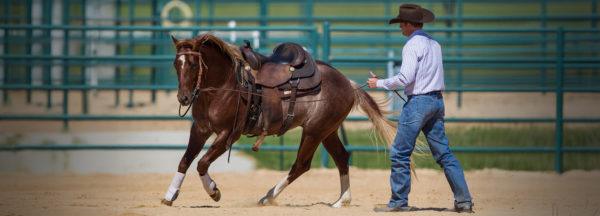Handling a Rearing Horse


Clinton Anderson: Handling a Rearing Horse - Downunder Horsemanship
Clinton Anderson from Downunder Horsemanship has developed a way to train horses, regardless of their past problems or traumas. It all begins with training the owners so they can gain their horse’s respect and understand how to properly control them. Join Clinton on his weekly endeavors of tackling some of the most challenging situations with problem horses, and problem owners. This week, we join Clinton as he shows us how to handle a rearing horse.
Clinton tells us that if your horse is trying to rear on the trail, you need to figure out why he’s rearing in the first place. Is he rearing because he’d rather be somewhere else, because he’s nervous or scared, or because he’s just plain disrespectful? Once you figure out the cause of the rearing, you can start working on addressing it.
If your horse is rearing out of disrespect, meaning he’s ignoring your cues and doesn’t want to move forward, it’s important to first get control of the horse on the ground. Get off your horse and practice Fundamentals groundwork with him. Do Lunging for Respect Stage One and Two and gain control of his movements. Once you accomplish that, you can get back on and keep moving.
When a horse rears because he doesn’t want to move forward, he is letting you know that you need to spend more time putting a foundation on him, taking him through all of the groundwork and riding exercises in the Fundamentals Series. It’ll be important to focus on basic impulsion exercises like the Cruising Lesson to teach the horse to respond to your cues and to be responsible for maintaining the gait you set him in. When you gently squeeze his sides with the calves of your legs, he should immediately move forward. All of the exercises in the Fundamentals series will help you with this.
If your horse is rearing because he’s nervous and reactive, get control of the situation by yielding his hindquarters. When a horse crosses his back legs over one another, it takes away his balance. Without balance, the horse can’t stand on his hind legs and rear. Think of yielding the horse’s hindquarters like pushing the clutch in on a car, you’re taking the power away from the horse. Yielding the hindquarters also gets the horse to stop thinking about being disrespectful or fearful and makes him concentrate on where he’s placing his feet.
The key is making sure that you work with the fundamentals and always build a strong foundation. If your horse is not broken in, make sure that you avoid riding him until you’ve gone through some groundwork training and gained his respect. Then, by the time you start riding him, he won’t rear and he won’t buck because you’ve done the necessary homework on the ground.
There are some horses in Clinton’s career that have been so badly trained and so ingrained with bad habits that Clinton didn’t even try riding them for the first two weeks he had them in for training. When he finally did ride them, after the proper groundwork training, he had no problems with them. You need to work with your horse on the ground for as long as it takes until you can get him calm, respectful, and using the thinking side of his brain. It’s all about getting the horse soft and relaxed. Then once you ride your horse, you won’t have to worry about bad behavior like bucking or rearing. You need to get all of the dangerous behavior taken care of while you’re on the ground where it’s safe.
Groundwork allows you to achieve good control and grow your confidence as a horseman. It’s designed to keep you safe in the saddle. You don’t want to ever put yourself in a vulnerable position with your horse on the trail unless you’re 99% sure that you’re going to be the one in control and calling the shots. Preparation leads to success.
For the past 20 years Clinton Anderson has devoted his life to creating the best training tools and videos available to help bring his method to you. But there’s only one problem. You can’t bring your TV into the arena. That’s why he’s been hard at work, developing a new platform to deliver the Method to you in a whole new way, a way that brings 20 years of horsemanship and puts it in the palm of your hand. Introducing the mobile method. It’s part of the new Downunder digital experience. And it makes learning the Method easier than ever before.
Now you can always have access to the Downunder Method, even when you’re on the go or at the barn. The Downunder Horsemanship app gives you access to your digital training kits and allows you to download videos and training content directly to your mobile device or view them on your computer. The Downunder Horsemanship app also offers over 100 hours of free in-depth training content. No Worries Club members will have full access to Clinton’s ever-growing training library and a massive number of members only features and information. And the best part is that you can view and interact with each lesson on your mobile device or computer, giving you ultimate access to the method anytime and anyplace.
To learn more about the Clinton Anderson training method, become a member of the No Worries Club, or to get information on any of the products seen on our show, head over to our homepage and download the Downunder Horsemanship app. If you’re interested in getting accelerated results, let a Clinton Anderson Certified Clinician bring the Method to you!

